Executive Summary
In the early 2000s, it was noted that the British health care system experienced significant difficulties in storing the patient data and in sharing the specific medical information among facilities. To respond to the problem, it was proposed to launch the National Programme for IT in the National Health Service (NHS) in England. The purpose of the Programme was to improve the quality of the patient care while changing the approach to operating the medical data with the focus on the electronic recording systems and networks. Despite the clearly stated purpose for the developed project, the Programme was not successful enough because its major goals were not accomplished.
The current report provides a review of the National Programme for IT in the National Health Service with the focus on analysing the issues observed during the project implementation according to the project management theories and concepts. The report also aims to provide the recommendations on improving the approach to the project development with the focus on the identified issues.
Background Information
The National Programme for IT in the National Health Service in England (NHS) was launched in 2002 (National Audit Office 2008). The Programme was designed to advance the health care services in the country with the focus on the improvement of the quality of patient care and the delivery of services (National Audit Office 2008). The purpose of the Programme was to improve management of health care services, to ensure transmitting the accurate patient information within the NHS system, to reduce the risk of errors, to guarantee the effective electronic communication, and to make the overall provision of services efficient (National Audit Office 2008, p. 16).
Focusing on the scope of the National Programme for IT in the NHS, it is important to state that the Programme was developed as a set of projects oriented to increasing the patient safety and data security, advancing the care delivery, and increasing the efficiency of provided services. The main project was the implementation of the NHS Care Records Service, including Summary Care Records and Detailed Care Records (Brennan 2005; National Audit Office 2008, p. 16). The associated project was the implementation of N3 as the national networking service to support the connection and accessibility in the NHS. Choose, and Book was designed to be implemented as the electronic booking service to guarantee the patient choice. The next project was the Electronic Prescription Service. The Spine was developed to store patient data. The other projects were proposed to be implemented to support the NHS IT network (Brennan 2005; National Audit Office 2008).
Analysis of Issues
The Programme was developed to reform the NHS in the country, and it was based on the budget in £12.7 billion, as it was stated in 2008 (Brennan 2005; National Audit Office 2008). Despite the focus of the Programme on the complete integration of electronic care records and other elements in the NHS, the Programme was not implemented effectively because of a range of issues associated with drawbacks in project management. The barriers in project management and implementation of the Programme can be divided into several categories such as scope, planning, time, monitoring, and leadership (Bartlett 2004). These issues should be analysed in detail to propose alternative solutions to the identified challenges and problems.
Large Scope of the Project and Ineffective Planning
The issues related to the scope of the project and planning are placed in one category because of the dependence of the project’s effectiveness on the proper planning and because of the connection between the scope of the project and the aspects of planning. Referring to the scope of the Programme, it is possible to state that the Programme included too many projects to be implemented effectively without efficient planning and design. Focusing on the Open System Theory, it is important to note that the Programme that includes several projects should be discussed as a complex and open system (Carroll 2008; Kousholt 2007; Lock 2007). As a result, the implementation of all projects depends on the effective planning, according to which all stages and outcomes of the projects are determined (Kousholt 2007; Lock 2007).
The Programme was planned to be implemented in several phases; thus, the phased approach was selected for the project development (National Audit Office 2008; Nokes 2007; Wysocki 2009). The main focus was on the phases of the implementation stage. Phase 1 was planned to be completed in 2005, and it was focused on implementing the major initiatives such as the NHS Care Records Service, N3, Choose and Book, and the Electronic Prescription Service. Phases 2 and 3 were planned to start in 2006 and end in 2010 (National Audit Office 2008). During Phase 2, the additional components of the Programme were planned to be deployed. Phase 3 was planned to check and guarantee the functionality of the Programme’s components (Brennan 2005; National Audit Office 2008). However, although the scope of the project was effectively determined, the planning stage lacked important elements and steps. The resources, time, and budget for activities were estimated improperly. The schedule was developed with references to the tentative timeframes and non-clearly determined benefits. The preliminary work was not planned effectively. It was inadequate and incomplete. Thus, the initial training of the staff and education on the advantages and disadvantages of the Programme was not scheduled appropriately (Levine 2002; Phillips 2003; Schwalbe 2010). Risk planning was also ignored; as a result, there were no proposed alternatives.
It is possible to state that the project was too large to be managed effectively with the focus on inappropriate and incomplete planning. The effective project includes several stages that are initiation, planning, execution, controls or monitoring, and closeout, as it is represented in Figure 1 (Heldman 2011; Wysocki 2009). The main stage is execution during which leaders need to realise the regular control and monitoring to complete the project goals effectively. Any changes in the Programme were integrated into the project development, and the Execution stage was delayed. As a result, the Programme did not demonstrate the expected advantages and benefits at the Closeout stage.
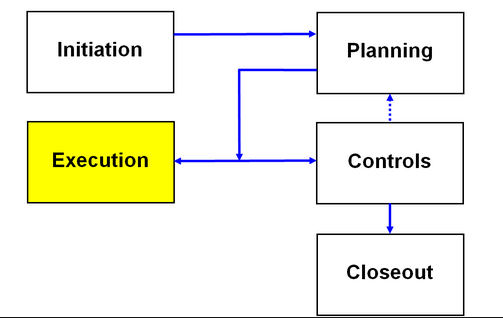
Ineffective Timetable
Time is one of the main interrelated constraints that influence project development and form the Project Management Triangle, including scope, time, and cost (Carroll 2008; Koster 2009; Kousholt 2007). The idea of the Project Management Triangle is presented in Figure 2. In addition to the barriers associated with the large scope, the Programme also used the ineffective timetable. The concept of time is one of the most important to influence the effectiveness of the project development and to affect the quality associated with the project results (Bartlett 2004). To contribute to the effective project completion, it is necessary to have enough time to realise all the activities (Brewer & Dittman 2013). Thus, scope, time, and cost are interrelated aspects (Chapman & Ward, 2003; Levine 2002; Phillips 2003; Schwalbe 2010).
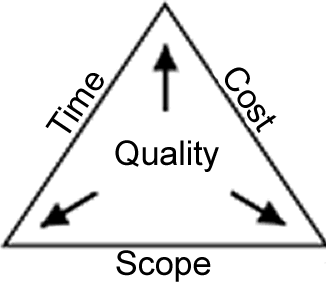
The main approach to discuss the effectiveness of the proposed timeline is to use the Gantt chart in which the milestones of the Programme and the timeframes are presented in general, according to the official report of the NHS (Carroll 2008). Figure 3 presents the Gantt chart that is relevant to depict the timeline of the discussed project.

The developers of the project addressed the issue of cost, and they set a tentative, but a rather unrealistic timetable that was not associated with the scope of the Programme (Brennan 2005; National Audit Office 2008). The budget allowed the effective realisation of the project within the determined timeframe, but the scope was too large to be addressed within the set timetable (Coulter 2009). Thus, it was scheduled to complete Phase 1 during two years and nine months, but there was a two-year delay, and the NHS Care Records Service was planned to be fully completed only before 2010 (National Audit Office 2008, p. 7). Phases 2 and 3 were planned to be also completed in 2010.
It is important to state that being focused on milestones in the project development, the provided timetable did not include the time for checking the effectiveness of the systems’ implementation and for overcoming challenges (National Audit Office 2008). The problem was also in the fact that the various unconnected timescales were proposed for different locations, and it was impossible to guarantee the completion of all steps of the implementation stage at the same time (National Audit Office 2008). As a result, the proposed timetable was discussed as unachievable because of the scope constraint and because of the ineffective set periods (Kerzner & Belack 2010). The proposed timescales were also rather tight to address the changes in the Programme.
Although the leaders chose the appropriate step-by-step method instead of the Critical Path Method to implement the projects of the Programme, the details of the schedule and plan were not taken into consideration, and the Programme failed (Kerzner & Belack 2010; National Audit Office 2008). While choosing the step-by-step approach, it is necessary to understand that the effectiveness of the further step depends on the completeness of the previous one. Instead, the main steps in the Programme were not completed effectively during the planned timeframes, and that fact influenced the whole development of the project negatively (Kousholt 2007; National Audit Office 2008). The delays during the Execution stage often leads to the failure because of the impossibility to continue the project development when one of the set steps is incomplete (Levine 2002; Phillips 2003; Schwalbe 2010; Wysocki 2009).
Monitoring and the Ineffective Choice on Corrective Actions
Monitoring of the project development is an important process that accompanies the Execution stage. Monitoring is necessary to identify challenges and problems associated with the project implementation, to evaluate the risks, and propose corrective actions to overcome the problems on time (Koster 2009). Although monitoring was planned by the developers of the Programme and challenges were identified, there were significant problems associated with checking the project progress against stakeholders’ expectations and with reporting problems in an appropriate manner (Kousholt 2007; National Audit Office 2008).
The Programme was effectively evaluated concerning determining milestones and the effectiveness of the ongoing project activities to achieve the set goals to guarantee benefits in the future (National Audit Office 2008). However, the issues were associated with proposing corrective actions and testing systems to avoid further problems. Thus, the progress against cost, scope, and time was monitored regularly, and the challenges were easily identified (Brennan 2005). Nevertheless, the problem was in proposing appropriate corrective actions. For instance, the implementation of the software was associated with many technical issues that were easily identified during the monitoring stage. Still, no effective strategies were proposed to overcome the problem and enhance integration (National Audit Office 2008).
Monitoring of the project implementation is based on the effective reporting procedure (Levine 2002). Still, it is possible to state that the Programme had no effective reporting procedure because the participants of the project were not informed how to deal with the large volumes of data and to whom report at different stages of the project (National Audit Office 2008). As a result, it was rather difficult to use the advantages of monitoring and quickly resolve the identified problems to respond to changes in the Programme’s development and scope.
Ineffective Leadership
Although all factors are important to discuss the ineffectiveness of the project development, much attention should be paid to the role of leadership in the process. Issues associated with the implementation of the Programme are related to different aspects of leadership (Lock 2007). First, there was no clear division of roles and responsibilities between the local and central leaders controlling the project (National Audit Office 2008). As a result, a lack of clear leadership led to discussing non-achieving noticeable benefits within the set timeframes.
Second, the leaders of the project were focused on changing the project development to address the identified problems, but participants of the project were not effectively informed or trained to respond to the aim of the project and new changes (National Audit Office 2008; Nokes 2007). Third, the leaders did not demonstrate effective leadership and project management skills while discussing the Programme’s contracts. As a result, timeframes were ignored, and systems were implemented with significant drawbacks at the local levels because of the inabilities of leaders to address the issue. Furthermore, suppliers also ignored the timeframe, and the ineffective strategy led to significant delays (National Audit Office 2008; Schwalbe 2010). The ineffective leadership at the local and central levels led to changing the schedule of the project development and to changing the deployment frames from 2008-2010 to 2014-2015 (National Audit Office 2008).
Leadership skills are important to develop projects because ineffective management often results in the project failure, in non-achieving complete goals, and in using any extra resources (Brewer & Dittman 2013; Phillips 2003). Even though the Programme was implemented within the budget limits, its timeframe and scope were changed several times because of the unsuccessful management of the project (Brewer & Dittman 2013; Wysocki 2009).
Conclusion and Recommendations
To guarantee the effective implementation of the Programme, it is necessary to decide on the approach to follow while integrating and developing projects. It is possible to use the critical path while implementing the components of projects and programmes or implement the components one-by-one to achieve certain milestones. The leaders of the NHS Programme chose the second approach. However, it was not effective enough to guarantee the achievement of expected benefits. That is why it is necessary to recommend a range of strategies to guarantee the effective development of the project.
- More attention should be paid to the initiation stage, during which the managers need to determine the scope of the project effectively to address all the aspects during the planning stage.
- The Planning stage is important for the project because during this stage leaders determine all the aspects of the Programme and phases to complete. The leaders of the project did not state the testing and training phases clearly in their plan. As a result, the problems with planning led to the development of the ineffective schedule and to further delays during the Execution stage. Thus, much attention should be paid to effective planning according to the cost, scope, and time of the project.
- The next important recommendation is the focus on effective leadership. The problems in project implementation were associated with ineffective leadership because of the improper division of tasks and responsibilities between the local leaders and NHS leaders.
Project Plan Dossier on Lorenzo Implementation
Background Information
The Bury Lorenzo Regional Care is a project developed in the context of the National Programme for IT in the NHS in England. The project is based on the implementation of the specific software to support iSOFT’s Lorenzo system to improve the storage and share of the medical information in the North, Midlands and East of England. The improvement of the communication between the facilities in the North, Midlands and East of England is the main goal of the IT project. The Bury Lorenzo project was launched along with the other components of the National Programme for IT in the NHS in 2002. However, the project was updated several times because of the delays in the development and because of the necessary upgrades.
The current project plan dossier includes the improved versions of the plan for the Bury Lorenzo project to guarantee the achievement of the set goals. Thus, the project plan dossier consists of the scope of the project, the developed project plan, the risk management plan, and the discussion of the organisational structure referred to the implementation of the Bury Lorenzo project. The plan is developed with the purpose to avoid delays and guarantee the completion of all the set stages.
The Scope Statement
To determine the scope, it is necessary to focus on the tasks determined as priorities for completing the project. Thus, the purpose of the Bury Lorenzo project is to improve the quality of the patient care in the North, Midlands and East of England with the focus on the development and implementation of iSOFT’s Lorenzo system. To realise the purpose of the project, it is necessary to focus on the implementation of a range of IT components to create the effective electronic communication system for the facilities in the North, Midlands and East of England (Community Services Bury Board 2010; NHS 2002; Williams 2008).
The main components of the project that need to be implemented from 2002 to 2010 are the following ones: Summary Care Records, Detailed Care Records, N3 Infrastructure, Electronic Prescription Service, Choose and Book System, the specific Picture Archiving System, Data Spine System, and the NHS Mail. The rationale for implementing these IT elements is based on the idea of improved communication and the active share of medical information among the facilities (Community Services Bury Board 2010).
Project Plan
Project Milestones and Deliverables
To guarantee the appropriate completion of the Bury Lorenzo project, it is necessary to determine milestones and deliverables, according to which it is possible to control the progress of the project (Highsmith 2009). In case of the Bury Lorenzo project, the implementation of the main components can be discussed as appropriate milestones. To guarantee that the project is completed efficiently, it is necessary to focus on the deployment of the Summary Care Records only after the development of the system for the Detailed Care Records (Community Services Bury Board 2010; NHS 2002). However, it is possible to implement Detailed Care Records only after the development of the N3 IT infrastructure that needs to be tested before the final deployment in the system (Community Services Bury Board 2010; NHS 2002).
The next stage after the initial implementation of N3 IT infrastructure is the encryption and security procedures. The implementation of the NHS Mail System also depends on the effective completion of the N3 IT infrastructure deployment (Community Services Bury Board 2010; NHS 2002; Kerzner 2009). The integration of all the elements of the N3 IT infrastructure is also essential for the implementation of Choose and Book System. It is important to focus on the fact that Picture Archiving System can be effectively deployed only after the integration of Image Sharing Software Programme that should be discussed as the separate component dependent on the development of the N3 IT infrastructure (Community Services Bury Board 2010; Highsmith 2009; NHS 2002; Thomsett 2002).
The Network Diagram is an effective tool to demonstrate the relationship between the identified project deliverables that are associated with the implementation of the Lorenzo system (Kerzner 2009; Thomsett 2002). Figure 1 presents the Network Diagram developed to explain the relationship between the milestones in the Bury Lorenzo project.
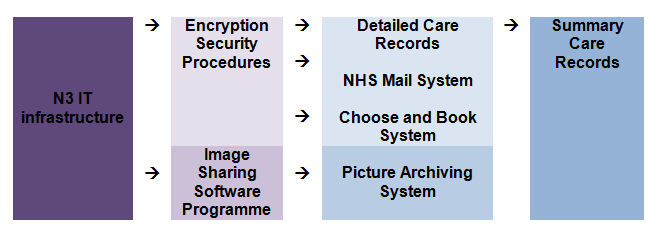
Project Schedule
The most appropriate tool proposed in the field of project management to develop the schedule and determine the timeline for the process is the Gantt chart that includes the duration of the main phases and appropriate start and end dates for the completion of the project stages (Harvey 2005; Kliem, Ludin & Robertson 2009). Figure 2 represents the Gantt chart developed for the Bury Lorenzo project. Six phases are proposed for the implementation of the project. Although the proposed phases are standard, it is necessary to improve the schedule in terms of the planned dates. It is possible to present the timeline for the project and the improved schedule with references to the waterfall model where all the phases of the project are completed according to the linear sequence. Six proposed phases are “build, debug, trial deployment, review, feedback, and rollout” (NHS 2002, p. 2). Following the standard timeline, these phases should be completed in less than five years. The Build stage can be completed in 12 months. The Debug stage is the shortest one, and it usually lasts two months. The Trial deployment is realised for 12 months. The feedback is accepted and analysed during the following six months. Finally, the Rollout stage can be completed during the next two years (Kliem, Ludin & Robertson 2009; NHS 2002, p. 2).
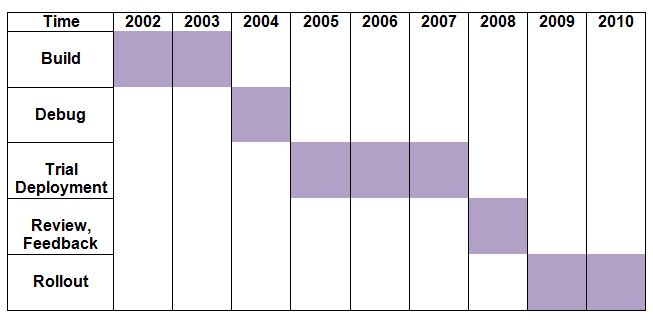
The improved schedule should include the proposed standard phases, but much revision is necessary regarding the set time periods for the completion of different stages of the Bury Lorenzo project. It is important to make the Build stage longer to have the opportunities to address all the problems associated with the initiation of the project. The Debug stage should also become rather long to have the scope for providing all the necessary additions to the project according to the changes in the time and other factors (Kloppenborg 2011; Murch 2001). As a result, it is reasonable to start the Trial Deployment stage in 2005 and focus on its completion during the next three years. During this period, it is possible to collect the data on the project completion, to test the technical and IT components of the project to avoid problems in the future, to conduct the regular monitoring and control over the implementation of all components of the system. It is important to state that different timeframes should be proposed for the implementation of Summary Care Records, Detailed Care Records, N3 Infrastructure, Electronic Prescription Service, Choose and Book System, the specific Picture Archiving System, Data Spine System, and the NHS Mail because of the dependence of the components on each other.
The identified issues should be analysed and fixed during the Review stage. It is important to provide the managers and specialists with the additional time to complete this stage because of the importance of the effective corrective actions necessary to respond to the identified problems. The Rollout stage should be completed in two years because it is based on the implementation of the final revised project components and systems that are discussed as having few or no weaknesses (Harvey 2005; Schwalbe 2010).
Risk Management Plan
Risk management is an effective process in the project development because leaders determine the steps in the project implementation while referring to the risks identified during the initiation stage. The risk management plan includes possible risks that are discussed as relevant to the project, the discussion of the risks’ probability that can be measured as high, medium, or low, the discussion of the risks’ severity (high, medium, or low), and the discussion of the mitigation strategy (Harvey 2005; Schwalbe 2010). Risks associated with the implementation of the Bury Lorenzo project are presented in Table 1.
Table 1. Risks in the Bury Lorenzo Project
The identified risks can be divided into such groups as Financial Risks; Planning Risks; Leadership Risks; and Technical Risks. The proposed mitigation strategies are developed to prevent risks or eliminate their negative effects on the process of project development. It is necessary to state that the Leadership Risks are the most influential among these categories because ineffective leadership causes the problems with the planning, with development of the effective timeline, and with the control of the project budget. It is important to state that the Financial Risks are also influential, and they should be addressed effectively because the lack of funding often leads to closing the projects (Cleland & Gareis 2006; Roberts 2011). As a result, the expected benefits are not achieved, and the financial loss can be observed in this case. That is why much attention should be paid to the mitigation of the Leadership and Financial Risks as influencing the other identified categories of risks.
Organisational Plan
The problems experienced during the implementation of the Bury Lorenzo Project are also associated with the complex organisational structure of the project. To complete the project within the National IT Programme in the NHS, it is necessary to organise control and monitoring at the central facilities and in local centres. From this point, the responsibilities for the implementation of the Bury Lorenzo Project are shared between the representatives of the Department of Health as the project developers; the project monitors appointed by the Department representatives; the regional project managers in the North, Midland, and East of England; and the monitors of the project implementation Acute Trusts, Mental Health Trusts, and Primary Care Trusts.
The complexity of the project can be discussed as the barrier to its effective completion. However, the proposed organisational structure can be discussed as rather effective to respond to the needs of the project if all the determined responsibilities and tasks are appropriately completed by the project participants (Chin 2004; Community Services Bury Board 2010; Nagarajan 2005). To address the problem of the complexity of the project, it is necessary to propose the most appropriate variant of the organisation, according to which the responsibilities and roles are distributed among the project participants (Cleland & Gareis 2006; Roberts 2011). The organisational structure related to the Bury Lorenzo Project is presented in Figure 3.
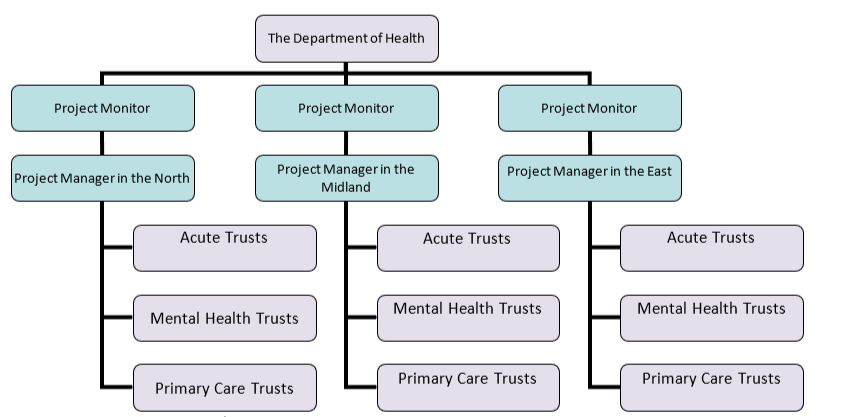
Conclusion
The Bury Lorenzo Project can be completed successfully and demonstrate the achievement of such benefits as the improvement of communication between the medical facilities in different regions of England if the project plan is developed according to the basic project management standards. To contribute to the success of the project implementation, it is necessary to focus on the initiation stage, to predict all possible risks, and to develop the mitigation strategies. The second step is the development of the effective plan in which all the aspects of the project should be mentioned. The development of the plan is directly associated with the discussion of the schedule. It is necessary to state that the Bury Lorenzo Project can benefit if the non-tight timeframe is proposed. The reason is that the process of implementing the software and IT systems in different regions of England is associated with a lot of technical challenges and barriers that cannot be addressed effectively and immediately.
The necessity to conduct several upgrades during the project implementation supports the idea that the overall schedule should be referred to several years. The current project plan dossier includes the discussion of the project scope, the project schedule and the network diagram presenting the milestones or components of the project, the risk management plan, and the organisational structure to follow during the completion of the project. The Bury Lorenzo Project failed because of the impossibility of the project management to predict risks associated with the project progress and to provide effective alternative strategies. As a result, the proposed project plan dossier aims to provide the improved variant of the plan for the Bury Lorenzo Project.
Reference List
Bartlett, J 2004, Project risk analysis and management guide, Association for Project Management, High Wycombe.
Brennan, S 2005, The NHS IT project: The biggest computer programme in the world, ever! Radcliffe Publishing Ltd., Oxford.
Brewer, J & Dittman, K 2013, Methods of IT project management, Purdue University, West Lafayette, Indiana.
Carroll, N 2008, Project management: A decision-making approach, Lippincott Williams & Wilkins, Baltimore.
Chapman, C & Ward, S 2003, Project risk management: processes, techniques and insights, John Wiley & Sons, New York.
Coulter, M 2009, Strategic Management in Action, Pearson Higher Education, New York.
Heldman, K 2011, PMP: project management professional, Wiley, Indianapolis.
Kerzner, H & Belack, C 2010, Managing complex projects, Wiley, Hoboken.
Koster, K 2009, International Project Management, SAGE, New York.
Kousholt, B 2007, Project management: Theory and practice, Forlag Publishing, NewYork.
Levine, H 2002, Practical Project Management: Tips, Tactics, and Tools, John Wiley & Sons, Hoboken.
Lock, D 2007, Project management, Gower Publishing Ltd., London.
National Audit Office 2008, The National Programme for IT in the NHS: progress since 2006, National Audit Office, London.
Nokes, S 2007, The Definitive Guide to Project Management, Prentice Hall, London.
Phillips, J 2003, Project Management Professional Study Guide, McGraw-Hill Professional, New York.
Schwalbe, K 2010, Information technology project management, Cengage Learning, Boston.
Wysocki, R 2009, Effective Project Management: Traditional, Agile, Extreme, John Wiley & Sons, New York.
Chin, G 2004, Agile project management: how to succeed in the face of changing project requirements, AMACOM, Portland.
Cleland, D & Gareis, R 2006, Global project management handbook, McGraw-Hill Professional, New York.
Community Services Bury Board 2010, Lorenzo Regional Care Implementation – Update, Lorenzo Project Board, London.
Hamilton, A 2004, Handbook of Project Management Procedures, TTL Publishing, New York.
Harvey, L 2005, Project Portfolio Management, A Practical Guide to Selecting Projects, John Wiley & Sons, New York.
Highsmith, J 2009, Agile project management: creating innovative products, Pearson Education, New York.
Kerzner, H 2009, Project management a systems approach to planning, scheduling and controlling, John Wiley & Sons, New York.
Kliem, R, Ludin, I & Robertson, K 2009, Project management methodology a practical guide for the next millennium, CRC Press, New York.
Kloppenborg, T 2011, Contemporary project management, Cengage Learning, New York.
Murch, R 2001, Project management: best practices for IT professionals, Prentice Hall Professional, New York.
Nagarajan, K 2005, Project management, New Age International, New Delhi.
NHS 2002, Lorenzo Project – tasks, NHS, London.
Roberts, P 2011, Effective project management, Kogan Page, London.
Schwaber, K 2004, Agile project management with scrum, Microsoft Press, Boston.
Schwalbe, K 2010, Information technology project management, Cengage Learning, Boston.
Thomsett, R 2002, Radical project management, Prentice Hall Professional, New York.
Williams, M 2008, The principles of project management, SitePoint Pty Ltd, Collingwood.